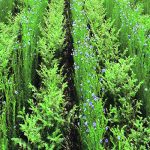Oilseed and pulse intercrops can result in better yields and nutrient use, according to research conducted at the University of Saskatchewan. “Legumes are a good choice for intercropping due to their ability to biologically fix nitrogen, which can reduce competition for nitrogen in an intercrop system,” said Melanie Reid from the U of S. During […] Read more
Tag Archives intercropping — page 2

General Mills, research farm look at oats intercropping
A food industry giant is partnering with a Saskatchewan research farm to learn more about the benefits of intercropping oats. General Mills, Inc. and the South East Research Farm in Redvers are joining forces, with funding from the company, to run trials to see whether peas grown with oats improves oat quality and nutrient density […] Read more

Sask. researcher sees intercropping on the rise
Three of last year’s top crop combinations were canola and peas, peas and oats (for silage), and flax and chickpeas
An old farming practice is winning new adherents across the Prairies. Intercropping — the growing of two or more types of plants in the same row or field, such as peas and canola — is catching on as good yields and lower production costs improve the bottom line. Crop specialists say healthier soils are another […] Read more
Sustainability finding home in mainstream agriculture
It’s pretty easy to scoff at the term “sustainable” when it’s bandied about by urban hippies. It’s harder to laugh off when hardcore agronomic and marketing professionals embrace the terms. And in finding ways for commercial farmers to embrace both profitability and sustainability, professionals such as Lana Shaw and Brenda Tjaden are also discovering a […] Read more

Intercropping canola and peas shows increased net returns
Saskatchewan farmer Sheldon Dowling describes his first experience with intercropping as interesting. In fact, the results from his pea-canola experiment in 2017 were so interesting that he decided to try it again this year. “Interesting is the key word,” said Dowling, who farms near MacDowall, Sask., near Prince Albert. “It’s pretty counter-intuitive to apply no […] Read more

Intercropping has merit, but challenges still exist
Trials have shown reduced disease with a chickpea-flax intercrop, but some are skeptical about a mustard-pulse or canola-pulse mixture
In the midst of diseased lentil fields last year, some growers might have noticed healthier crop stands where wild mustard was present. “There are a lot of anecdotes where they said the only place where they had any kind of lentils worth harvesting is where they had some wild mustard weeds. The lentils were climbing […] Read more



